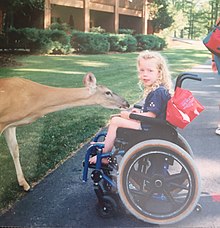| Spastic cerebral palsy | |
|---|---|
 | |
| A child with spastic cerebral palsy | |
| Specialty | Neurology |
Spastic cerebral palsy is the type of cerebral palsy characterized by spasticity or high muscle tone often resulting in stiff, jerky movements.[1] Cases of spastic CP are further classified according to the part or parts of the body that are most affected.[2] Such classifications include spastic diplegia, spastic hemiplegia, spastic quadriplegia, and in cases of single limb involvement, spastic monoplegia.[3]
Spastic cerebral palsy affects the motor cortex[1] of the brain, a specific portion of the cerebral cortex responsible for the planning and completion of voluntary movement.[4] Spastic CP is the most common type of overall cerebral palsy, representing roughly 80% of cases.[2] Spastic CP is a permanent condition and will affect an individual across the lifespan.[5] The brain injury that causes spastic CP remains stable over time, but the way spasticity affects a person can change.[1] For example, with age they may develop bone deformities from the pull of spastic muscles, muscular deterioration, and loss of range of motion in a joint.[1] Thus, individuals with spastic CP often have different support needs with time.[6]
- ^ a b c d "Spastic cerebral palsy". Cerebral Palsy Alliance. 2015-11-18. Retrieved 2020-03-10.
- ^ a b "What is Cerebral Palsy?". Centers for Disease Control and Prevention. 2019-04-30. Retrieved 2020-03-04.
- ^ "Cerebral palsy spastic monoplegic". Genetic and Rare Diseases Information Center (GARD). Retrieved 2020-03-10.
- ^ Knierim, James (2020). "Chapter 3: The motor cortex". Neuroscience online: An electronic textbook of the neurosciences from the University of Texas at Houston. Retrieved 4 March 2020.
- ^ "Spastic diplegia cerebral palsy". Genetic and Rare Diseases Information Center (GARD). 7 August 2018. Retrieved 2020-03-10.
- ^ Haak, Peterson; Lenski, Madeleine; Hidecker, Mary Jo Cooley; Li, Min; Paneth, Nigel (2009). "Cerebral palsy and aging". Developmental Medicine and Child Neurology. 51 (4): 16–23. doi:10.1111/j.1469-8749.2009.03428.x. ISSN 0012-1622. PMC 4183123. PMID 19740206.